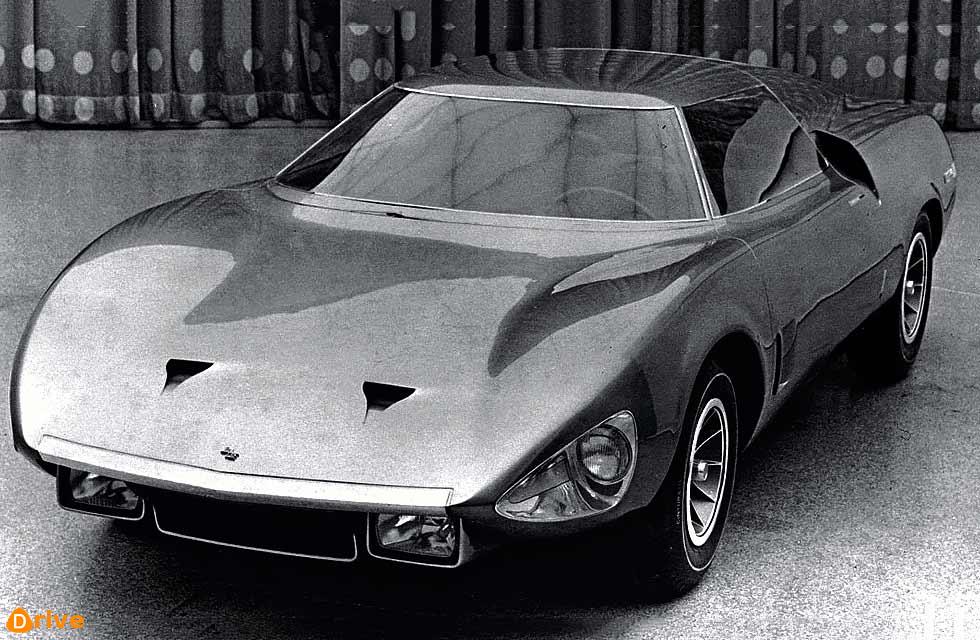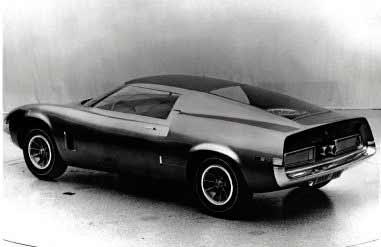Ford Bearcat When is a show car not a show car… we’d venture to say that probably when it’s never been ‘shown’! Richard Heseltine uncovers one such vehicle that never even saw the light of day…
Front end styling reminiscent of Italian exotica
Concept cars, teasers, show queens – call them what you will – are generally built to gauge public reaction. Either that, or to project forthcoming styling features which will filter down on to mainstream production models. The car seen here never saw daylight, let alone a stand in an exhibition hall. It was a one-week wonder, with only these shadowy pics emerging from Ford’s design studio in Dearborn, Michigan to prove that it ever existed. What’s more, it barely qualified as a ‘car’ given that it never ran under its own steam. It was but a mere mock-up, but the Bearcat remains intriguing because of what it might have become: imagine a road-going, mid-engined GT car offered to the public at the height of the Blue Oval’s Total Performance programme; a sort of GT40-lite available for mass consumption. A tantalising prospect, isn’t it?

There had been prior attempts at building a mid-engined Ford sports car, the open-top, V4-engined Mustang 1 from 1962 being the most memorable. A coupé variant was apparently considered for production, but we can find no corroboratory evidence of this as it seems to have existed only in rendering form. The Bearcat was created in 1967, and its existence was seemingly lost on North America’s automotive media. Oddly, it was Great Britain’s Autocar magazine which revealed news that Ford was considering making a gen’wine junior supercar.
The motoring weekly reported: “With all contemporary racing cars featuring mid-mounted engines, and with Ford’s interest in the competition scene, it was only a matter of time before they came up with a styling exercise based on this pattern. The Bearcat is a practical shape for a road car with a seating package similar to the current Mustang 2+2 fastback. It has been built from a clay model in glassfibre…
“The Bearcat features flush-moulded lamp covers and retractable high-intensity driving lamps which sit under the front bumper each side of the air intake. The whole of the rear bodywork hinges open as one piece for access to the engine bay behind the seats, and the roof section over the cockpit is designed to lift off and fit into the front compartment between the radiator and fascia. The spare wheel is above the gearbox, behind the engine. Behind the rear window is a hydraulic spoiler, with adjustable angle, and the tail lamps are hidden behind stainless steel panels which are perforated with millions of minute holes. The appearance is of a satin-finished opaque sheet until the lamps come on.”
Notionally powering this machine was a small-block V8, packaged within an overall length of 4648mm (183in) and a wheelbase of 2641mm (104in). The Bearcat was 1920mm (75.6in) wide and stood 1209mm (47.6in) off the deck. As to what happened next, we’re guessing the ‘car’ was scrapped. As a codicil to the story, Ford’s Special Vehicles Group also came up with a mid-engined supercar proposal under the leadership of Gene Bordinat: the Mach 2. This wedge-shaped device was built near concurrently, and, unlike the Bearcat, it was seen publicly but never made it into series production. When Ford did finally put its weight behind a mid-engined street car, it was by means of sponsoring the De Tomaso Pantera, which was sold through the Lincoln-Mercury dealer network. The relationship with the Blue Oval and the Italian firm ended badly…

Richard Heseltine’s weird and wonderful American cars from the past





